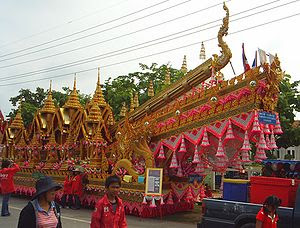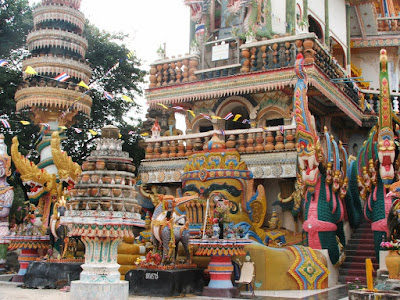Hot Traveler's Thailand
วันพฤหัสบดีที่ 29 ตุลาคม พ.ศ. 2558
Bun Bangfai Festival.Roi-Et ,Thailand
Bun Bangfai Festival (ประเพณีบุญบั้งไฟ) (aka 'The Rocket Festival'): The festival is organised annually around June. Every district organises colourful parades of Bangfai rockets that reflect the folk culture and local traditions of Roi Et Province, especially the parades from Phanom Phrai and Suwannaphum districts will be lavishly decorated.
Bun Phawet Festival. Roi-Et ,Thailand
Bun Phawet Festival (งานประเพณีกินข้าวปุ้นบุญผะเหวด): First held in 1991, it has been held annually around early-March every year ever since. The event takes place at the Somdech Phra Srinakarindra Park and Bueng Phalan Chai. Bun Phawet, or known in the central region as Bun Mahachat, is usually held in the 4th lunar month. It is a Buddhist ceremony in which the monks give a sermon of all chapters of the Vessantara Jataka, otherwise called the Great Birth Sermon. There are also 13 parades of Phawet, according to the number of the chapters of the sermon, arranged by various public and private organisations. The area around Bueng Phalan Chai has stalls providing free "khao pun", rice noodles, for participants. There are also contests of traditional arts and culture such as making the "bai si su khwan" tray.
Noon Sawan Temple. Roi-Et ,Thailand
Noon Sa Wan Temple is not a big temple. The style and architecture is similar to the temple in abbots dream. It is located in Ban Yangdor, Tambol Thutthai, Maung Roi-Et. The temple is 18 km from Roi-Et. It is open every day and there is no entrance fee.
Biography of the abbot Abbot of Wat Pa Noon Sa Wan. He was born on January 11, 1933.
He came from a big family. He had 4 sisters and 6 brothers. He asked for the permission of his father and mother to be a monk, when he got 19 years old. He was a novice for two years. He became a monk in 1954. Since that day, he has studied Buddhism and religious rites. He also went on pilgrimages to many different places. In order to learn more, he studied with many famous monks about Buddhist miracles. He had extended his belief by giving sacred objects to people who come to the temple. They were things such as the small flag of “Pha Yun" and others.The inspiration in building templeLong time ago, the abbot arrived at the forest hill temple, which was in Thawatburee distict, Roi Et. The abbot thought that the place was good for relaxation and meditation. He then built a house at the hill as his residence. The abbot lived for many years and the villagers had faith in him. One day the abbot was meditating in his small hut. Suddenly he saw a temple coming from the sky, above where the abbot was sitting. The abbot thought this was a sign and he wanted to build the temple.
He came from a big family. He had 4 sisters and 6 brothers. He asked for the permission of his father and mother to be a monk, when he got 19 years old. He was a novice for two years. He became a monk in 1954. Since that day, he has studied Buddhism and religious rites. He also went on pilgrimages to many different places. In order to learn more, he studied with many famous monks about Buddhist miracles. He had extended his belief by giving sacred objects to people who come to the temple. They were things such as the small flag of “Pha Yun" and others.The inspiration in building templeLong time ago, the abbot arrived at the forest hill temple, which was in Thawatburee distict, Roi Et. The abbot thought that the place was good for relaxation and meditation. He then built a house at the hill as his residence. The abbot lived for many years and the villagers had faith in him. One day the abbot was meditating in his small hut. Suddenly he saw a temple coming from the sky, above where the abbot was sitting. The abbot thought this was a sign and he wanted to build the temple.
Klang Ming Mueang Temple. Roi-Et ,Thailand
Klang ming mueang temple stands far from the city hall goes to the north about a half kilometer. We arrive at Roi-Et bus- station . we have to take motorcycles. A driver takes us to Klang Ming Mueang Temple in 10 minutes. It costs us about 60 Bath. When enter temple, we have to be clam and polite. The weather in temple is cool and nice.The temple is compound of important sacred objects such as a main hall, the principal Buddha images, the old Chadok texts, small Buddha images, the Ming Muaeng palace, the Hor Tri, and a library. We should avoid as a taboo is entering to the church don’t step on the thresholds because it’s impolite and insult the holy things. The old people are trust in the holy. We can take a photo and ask for the information. When we finish to visit it we can walk to Sra Thong Temple because it is next to Klang Ming Mueang Temple. It takes 5 minutes on walking.
Klang Ming Mueang Temple, originally named “Wat Klang”. When they built this temple , there was not mentioned clearly. Anyhow, The North of the temple borders Suk Kasem road, the South of the temple borders Phadung phanich road, the East of the temple borders Jaloernphanich road and, the West of the temple borders Dumrong Radwitee road. It’s approximately 500 meters far from the center of the town.
Buddhist Temple Hall The Buddhist Temple Hall is in the Klang Ming Mueang Temple. It was built in 1547 during Ayuttaya period. In the Buddhist temple Hall, there is a big Buddha image called “Phaputta Ming Mueang”. It is very famous in Roi – Et and nearby. Outside the Buddhist temple hall there is the beautiful painting of 12 signs of the zodiac.
Phakung Temple. Roi-Et ,Thailand
57 years ago, LuengPhu Sri Mahaviroa (Phrathepwisuttimongkol) PhreAjarn Sing Khantayakamo and PhraAjarnMahaBuaYannasoomPanno were invited to live in this temple. In 1962 LuengPhu Sri Mahawiroa started to live in Ban Koa Temple (Phakung Temple). At the time, it was a deserted temple. It was very wild and old. It was 200 years old. Nobody went there, because they were afraid of ghosts and magic art. Before the temple was built, LuangPhusir invited PhraAjarn Sing Khantayakamo and PhraAjarnMahaBuaYannasoomPunno to come and see the land for building the temple. In 1984 King BhumibolAdulyadej, Queen Sirikit, Majesty Pratep and Princess Jurapon went to give an offering, especially robes to monks. After Buddnist Lent at Phrechakomwanaram Temple (PhakungTemple) they gave the private assets to the temple. On January 30, 1997, LuengPhu had a ceremony for laying the cornerstone at PhreMahaChadeeChaiMongkon, NongPhok District, Roi-Et Province; for containing the relics of the Buddha that were brought from Sri Lanka. In 2005, this Stone-Chedee was built to monument LuengPhu who turned to be 90 years old. 40 million baht was spent to build Phakung Pagoda. It sits on four Rais, which is 19 meters long and 40 meters wide. It has five floors. It is the stone-Pagoda with a golden top weighting 101 baht. Inside the Pagoda is decorated by sand-stone, granite and marble. The ceiling is made from auspicious tree. It is a unique and a fascinating place.
Location
Phakung Temple is located in Phakung village, SrisomdetDistict, Roi-Et Province. It is 537 kilometers away from Bangkok. RoiEt is easy to visit both by airplane and buses. Take the road that passes the following cities: Bangkok, Saraburi, Korat, Ban Pai, Mahasarakam and Roi-Et. It takes 6 hours from Bangkok. Phakung Temple is an identity of RoiEt and fascinating in beauty. When you are inside the temple you should dress appropriately and keep silent. It is a free entrance. The budget for building Stone-ChadeeWatPhakung was 40 million baht. It is on four Rais which is 19 meters long and 40 meters wide. It has five floors. It is a stone-pagoda with a golden top weighting 101 baht. It was decorated by sand-stone from Amphoeparkchong, Nakornrathchasrima province. Inside the pagoda, there are sandstone, granite and marble decorations. The ceiling is built from auspicious tree. It is a unique and a fascinating place.
Ku Phra Ko Na . Roi-Et ,Thailand
Ku Phra Ko Na
Location: Amphoe Suwannaphum
Ku Phra Ko Na is comprised of 3 brick prangs built on sandstone base, lining from north to south and facing east. The wall and gates at all 4 sides was also built with sandstone.
The central prang was renovated in 1874 by plastering and making the roof into tiers. Each tier has niches of Buddha images in four directions. The front of the central prang was a ‘wihan’ of the Buddha’s footprint, decorated with the original six-headed Naga. The northern prang was covered with a ‘sala’ building providing shelter for a gable depicting the Ramayana. The lintel carving representing the reclining Vishnu remains in situ above the front entrance. The lintel of the western false door was laid on the floor; it depicts the God Vishnu on his mount Garuda. The southern prang still has lintels above the false doors.
It is assumed that Ku Phra Kona formerly had a Naga bridge and causeway lined with boundary stones on both sides from the front entrance pavilion (Gopura) to the lake (Baray), which was located about 300 metres away. All sculptural features suggest that Ku Phra Kona probably dates from the Baphoun period, or the 11th century.The central prang was renovated in 1874 by plastering and making the roof into tiers. Each tier has niches of Buddha images in four directions. The front of the central prang was a ‘wihan’ of the Buddha’s footprint, decorated with the original six-headed Naga. The northern prang was covered with a ‘sala’ building providing shelter for a gable depicting the Ramayana. The lintel carving representing the reclining Vishnu remains in situ above the front entrance. The lintel of the western false door was laid on the floor; it depicts the God Vishnu on his mount Garuda. The southern prang still has lintels above the false doors.
Opening Hours: Daily from 08.30 am. - 04.30 pm.
Admission: FreeHow to get there: Take Highway No.215, pass Amphoe Mueang Suang, Amphoe Suwannaphum and then to Highway No.214, continue for 12 km. Ku Phra Ko Na is on the left.
Boorapaphiram Temple. Roi-Et ,Thailand
Boorapaphiram Temple was built in 1979. The It is located on 559 Phadungpanit Road, Mueng district,
Roi-Et. It was called “WatHou Raw” because in the former times, it was used as a hotel for the merchants who came to Roi-Et. They had business there at that time. There was not enough accommodation, so they had to stay at WatHou Raw. The word “Raw” means “waiting” in English, so at that time the merchants used this temple to sleep before started a new journey.
Roi-Et. It was called “WatHou Raw” because in the former times, it was used as a hotel for the merchants who came to Roi-Et. They had business there at that time. There was not enough accommodation, so they had to stay at WatHou Raw. The word “Raw” means “waiting” in English, so at that time the merchants used this temple to sleep before started a new journey.
AttractionsPhraBuddharattanamongkolmahamuni or Luangphoo Toe is the tallest standing Buddha statue, 30.30 meters tall, which is connected with Roi-Et province and called symbolic of Roi-Et. Most people who visit Roi-Et come to see this huge statue.
The object of the construction:They wanted to build a place to please the Buddha and have a symbol for Roi-Et that can bring foreigners to visit Roi-Et.
สมัครสมาชิก:
ความคิดเห็น (Atom)























